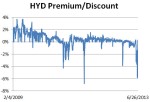MarketsMuse Editor Note: For those unfamiliar with the logistics of buying and selling corporate bonds in the secondary market, and particularly for those not fluent in why/how corporate bond ETFs are priced and trade, the following column courtesy of IndexUniverse’s Dave Nadig provides a good primer. Important take-away: if an executing broker attributes a poor execution to “not enough liquidity”, we respectfully suggest that you are likely using the wrong broker.
Apparently the last week around here has been iNAV week. With Matt calling for their banishment, me agreeing with him (much to my dismay) and Ugo Egbunike calling us both idiots.
And Ugo’s points are all valid. INAV can be a fantastic tool, and one which smaller investors can use to make money. The action in this week’s bond market is a fantastic case in point.
Now, bond pricing is a tricky thing. As Rick Ferri pointed out today in an excellent blog over at Forbes, when the liquidity of the bond market starts getting shaky, bond ETFs can trade well below their fair value. He uses that fact as reason to suggest avoiding bond ETFs. I see it as a trading opportunity.
Let’s pick a simple example I’ve been following all week: the Market Vectors High Yield Municipal Bond ETF (NYSEArca: HYD).
I’m not a bond master; I won’t tell you whether this week was a good or bad time to buy high-yield munis. But what I can tell you is that as a rule, it more often trades at a premium than a discount:
For the entire article, please visit IU’s site by clicking here
